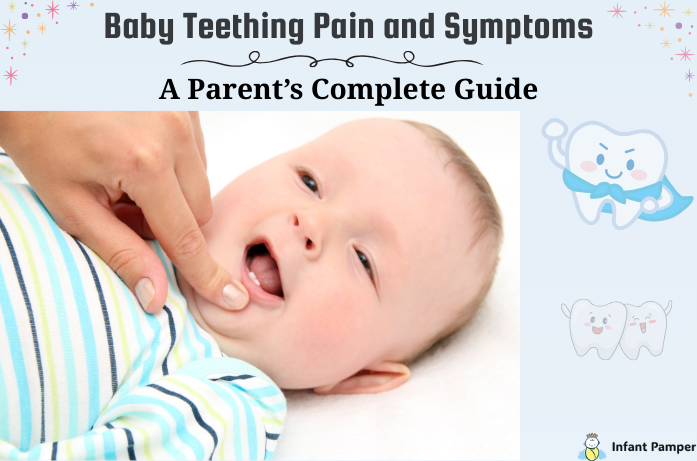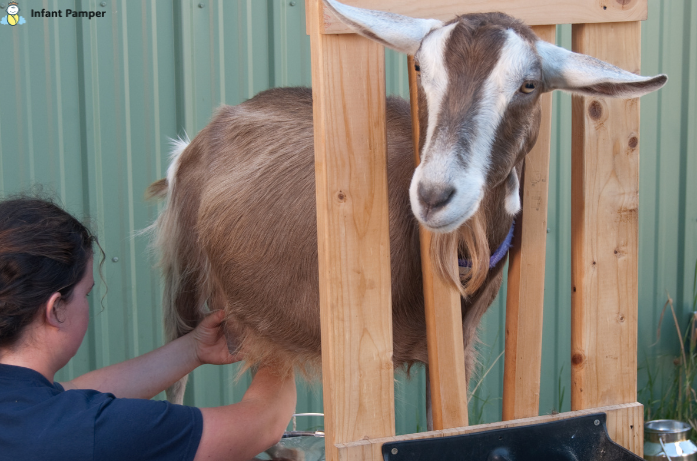By a caring mom at Infant Pamper
Your baby’s first tooth is a milestone worth celebrating, those little pearly whites are the beginning of a whole new chapter in their growth. But along with the excitement often come extra drool, restless nights, and a fussy little one. As parents, it’s only natural to want to ease their discomfort while also knowing what’s normal and what isn’t.
In this guide, we’ll break down everything you need to know about baby teething pain and symptoms: what teething is, the common signs, what teething does not cause, safe and gentle teething baby remedies, natural relief options, and the red flags that mean it’s time to call the doctor. By the end, you’ll feel prepared and confident to help your little one through this stage with comfort and care.
What is Teething?
Teething is the process when a baby’s primary teeth (milk teeth) begin to push through the gums. It usually starts between 4 and 7 months, though it can vary. Some babies sprout their first tooth earlier, while others may not get one until closer to 12 months.
- The first teeth to appear are usually the bottom front teeth (central incisors).
- By age 3, most children have a full set of 20 baby teeth.
- The process comes in stages, babies may teethe on and off for months before all teeth arrive.
👉 According to the American Academy of Pediatrics (AAP), teething is natural but can cause gum irritation, drooling, and changes in mood and sleep patterns.
Common Symptoms of Teething
Every baby is different, some breeze through teething with barely a whimper, while others find it more uncomfortable. Here are the classic teething signs you may notice:
- Excessive Drooling – Babies often drool so much during teething that bibs become essential. Prolonged wetness can lead to mild baby teething rash on the chin, cheeks, or chest.[Seattle Children’s Hospital]
- Chewing or Gnawing – Babies instinctively chew on toys, fingers, or anything handy to relieve gum pressure.
- Swollen, Tender Gums – You may notice red, puffy, or sore-looking gums, especially where a tooth is breaking through. [NHS]
- Irritability or Fussiness – Babies can be crankier, especially in the evening or at night when gum pain worsens.
- Sleep Disruptions – Sore gums often interfere with naps and night sleep. Shorter naps or frequent night waking are common.
- Mild Temperature Rise – Some babies get what’s called a “teething fever,” which is only a slight increase in temperature, not a true fever. (Mayo Clinic)
- Ear Tugging or Cheek Rubbing – Gum pain sometimes radiates to the cheeks or ears, leading babies to pull or rub.
- Reduced Appetite – Some babies refuse the breast, bottle, or solids for a few days due to gum discomfort.
💡 Tip: Every tooth can bring different symptoms, so what you notice with one may not be the same with the next.
What Teething Does NOT Cause
It’s important not to blame teething for every discomfort. Pediatricians, including guidance from Texas Children’s Hospital, emphasize that teething does not cause:
- High fever (over 38°C / 100.4°F)
- Severe diarrhea or vomiting
- Persistent cough or cold
- Severe rashes or skin infections
- Inconsolable crying lasting hours
👉 If your baby shows these symptoms, contact your pediatrician, they’re not normal teething signs and may indicate illness.
How to Comfort a Teething Baby
A common question among parents is how to best soothe teething pain. According to the Mayo Clinic, simple soothing strategies such as chilled teethers, gum massage, and extra comfort are usually enough, while medications should only be considered if symptoms are severe. Here are the safest and most effective methods:
1. Cold Relief
- Offer clean, chilled teething rings (not frozen, too hard and may hurt gums).
- A cold, wet washcloth (supervised chewing) works wonders.
- Chilled (not frozen) fruit in a mesh feeder can soothe gums for babies already on solids.
2. Gum Massage
- Use a clean finger to gently rub your baby’s gums.
- Gentle pressure helps ease pain and often calms babies instantly. [Children’s Hospital of Philadelphia]
3. Comfort and Distraction
- Sometimes, extra cuddles, rocking, or playtime help distract from the discomfort.
- Singing, walking outside, or offering a favorite toy can shift focus away from the gums.
4. Pain Relief (When Needed)
- If discomfort is severe, talk to your pediatrician about safe use of acetaminophen or ibuprofen (dosage depends on baby’s age/weight).
- Avoid teething gels with benzocaine or lidocaine, the FDA warns against their use in infants.
5. Protect Baby’s Skin
- Use soft bibs to absorb drool and change them often.
- Apply a thin layer of baby-safe barrier cream (like petroleum jelly) around the chin and neck to prevent rashes.
6. Choose Safe, Eco-Friendly Teethers
- Opt for silicone, natural rubber, or untreated wood.
- Avoid BPA, PVC, or chemical-laden products. (Environmental Working Group – EWG)
Natural and Gentle Teething Remedies
If you prefer natural approaches, here are parent-loved ideas:
- Breastfeeding or bottle-feeding – Sucking is soothing, even if baby drinks less.
- Chamomile tea-soaked cloth – (lightly chilled and safe for supervised chewing; only if approved by your pediatrician).
- Amber teething necklaces – Popular but not recommended by pediatricians due to strangulation and choking risks.
⚠️ Avoid amber teething necklaces, the American Academy of Pediatrics (AAP), warn of choking risks.
When to Call the Doctor
Most teething symptoms are mild and manageable, but call your pediatrician if your baby has:
- Fever higher than 38°C (100.4°F)
- Refusal to feed or drink for more than a few feeds
- Persistent diarrhea, vomiting, or signs of dehydration
- Severe rash, especially around the mouth or diaper area
- Extreme irritability or unusual drowsiness
👉Trust your instincts, if something feels off, it’s worth checking.
Baby Teething Timeline: What to Expect
Knowing what’s ahead can ease anxiety:
- 4–7 months: First teeth usually appear (lower central incisors).
- 8–12 months: Top front teeth erupt.
- 12–18 months: Molars start coming in, often the toughest stage.
- 18–24 months: Canines (pointed teeth) appear.
- 24–36 months: Second molars arrive, completing the set of 20 teeth.
👉 Understanding the baby teething timeline helps you prepare ahead with soothing strategies.
Gentle, Eco-Friendly Teething Care
Many parents today prefer baby products that are both safe and environmentally friendly. Some thoughtful swaps include:
- Organic cotton bibs instead of synthetic blends (gentle on skin and sustainable).
- Natural wooden teethers sealed with food-grade oil instead of plastic toys.
- Plant-based balms instead of petroleum-heavy creams.
These not only ease your baby’s teething journey but also support healthier choices for your family and the planet.
FAQs About Teething
Q1. Can teething cause my baby to stop sleeping through the night?
Yes, discomfort can disrupt sleep. Stick to routines and offer extra comfort.
Q2. Can teething cause ear infections?
No. Ear tugging during teething is due to referred gum pain. Persistent ear pulling + fever may mean an ear infection, see your doctor.
Q3. How long does teething pain last per tooth?
Usually a few days before and after a tooth erupts. Relief often comes once the tooth breaks through.
Q4. Do all babies experience teething pain?
No, some barely fuss, while others struggle more. Each child is different.
Final Thoughts for Parents
Teething is a natural (and sometimes messy) part of your baby’s development. With patience, love, and a few soothing strategies, you can help your baby through the discomfort and celebrate each new tooth as it arrives.
Remember:
- Mild fussiness, drool, and gum chewing are normal.
- High fever, diarrhea, or prolonged illness are not teething.
- Safe, simple remedies often work best, cold relief, gum massage, cuddles, and lots of comfort.
You’re not alone, millions of parents go through the teething stage, and it does pass. Soon enough, you’ll be rewarded with that first adorable toothy grin.
👉 Subscribe to Infant Pamper for trusted baby care tips and soothing solutions, straight to your inbox.




